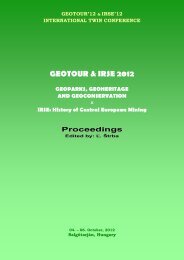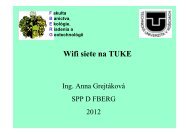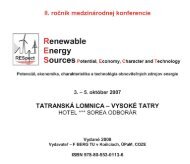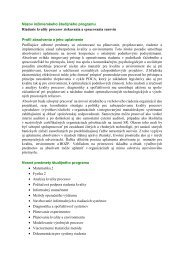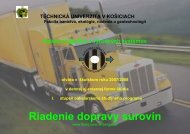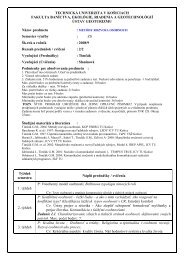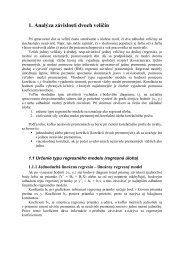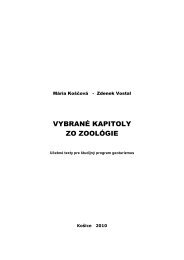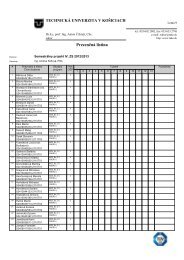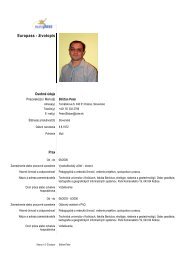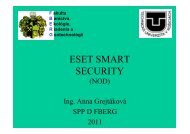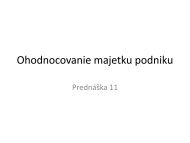GEOTOUR & IRSE 2012.pdf - Fakulta BERG - TUKE
GEOTOUR & IRSE 2012.pdf - Fakulta BERG - TUKE
GEOTOUR & IRSE 2012.pdf - Fakulta BERG - TUKE
You also want an ePaper? Increase the reach of your titles
YUMPU automatically turns print PDFs into web optimized ePapers that Google loves.
Salgótarján, 04. – 06. October 2012<br />
THE TELKIBÁNYA FIELD TRAINING EDUCATIONAL PARK IN WORKING ORDER<br />
Hartai Éva & Németh Norbert<br />
Institute of Mineralogy and Geology, University of Miskolc, 3515 Miskolc-Egyetemváros<br />
e-mail: foldshe@uni-miskolc.hu, foldnn@uni-miskolc.hu<br />
ABSTRACT<br />
The Institute of Mineralogy and Geology (University of Miskolc), the <strong>BERG</strong> Faculty (Technical University<br />
of Końice) and the Local Authority of Telkibánya established the Field Training Educational Park in 2010.<br />
The park is based on the diverse geology and the gold-silver ore mineralization around Telkibánya, on the<br />
remnants of the ancient mining and on the existing touristic facilities (including a museum of mining) of the<br />
locality. It consists of an educational centre attached to a youth hostel inside the village, an educational trail<br />
in the Veres-víz mining area and an underground demonstration site in the conserved Mária Adit. The park<br />
can be used by student groups for education, by professionals for meetings, and also by civilians for tourism,<br />
widening the offers at Telkibánya.<br />
Introduction<br />
Telkibánya is an ancient mining town in the Tokaj Mts (also referred by geographers as Zemplén<br />
Mountains), NE Hungary, close to the Slovakian border and the town Końice. It is surrounded by<br />
forest-covered hills with outstanding medieval and later objects of industrial history (adits, shafts,<br />
remnants of processing plants etc). Mining activity produced gold and silver from the veins of an<br />
epithermal mineralization, which is still the potential target of prospecting projects. The village is<br />
frequented recently by tourists, with several accommodations and recreational facilities. There is<br />
also a museum dedicated to the history of mining and industry together with the wildlife and the<br />
minerals in the building of a former porcelain manufacture.<br />
In 2004–2005 a feasibility study of a common Hungarian-Slovakian field educational centre was<br />
worked out in the frame of a PHARE CBC project lead by the Institute of Mineralogy and Geology,<br />
University of Miskolc, in which educational programs were proposed to realize in the mining area<br />
including the underground and open-pit mines. The partners of the institute were the <strong>BERG</strong> Faculty,<br />
Technical University of Końice and Telkibánya Local Authority. Based on this feasibility study a<br />
proposal for the realization was submitted and supported by the HUSK Cross-border Co-operation<br />
Program 2007–2013. The project was implemented in 2009-2010. In this article the facilities of the<br />
Educational Park are briefly introduced. The recent knowledge about the geology, mineralization<br />
and mining of Telkibánya was summarized in a volume of the Publications of the University of<br />
Miskolc in 2009, edited by the authors of the present text; in the recent paper mainly the articles of<br />
this publication are referred.<br />
The natural and historic background: geology and mining of Telkibánya<br />
The Tokaj Mountains are built up by volcanic rocks of Miocene age (formed 14-10 million years<br />
ago) such as andesite, dacite and rhyolite (Fig. 1). The thickness of the volcanic mass is cca. 3000<br />
m. Similarly to the recent volcanoes, the volcanic complex is built up by altering lava flows and<br />
pyroclastics. The volcanic activity lasted for about five million years, in three major phases,<br />
partially on dry land, partially in the sea. During the volcanism sediments like clay and pebbles<br />
were also deposited. As a result of the hydrothermal alteration of the rhyolitic tuff, „noble clay‟<br />
deposits were also exploited e. g. at Füzérradvány (Gyarmati 1977, Zelenka et al. 2012).<br />
6



